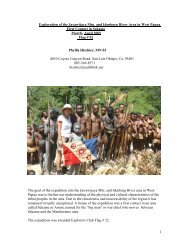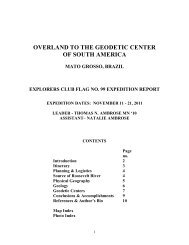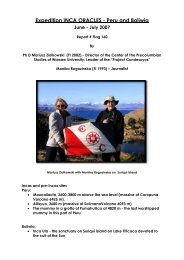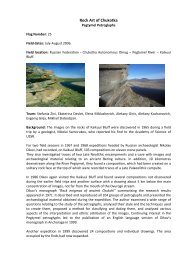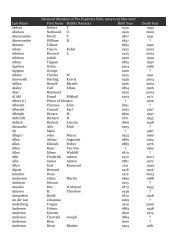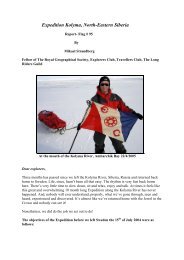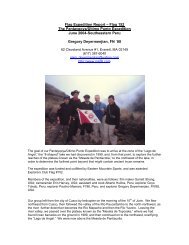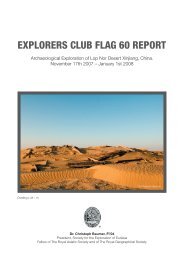the explorers journal the global adventure issue - The Explorers Club
the explorers journal the global adventure issue - The Explorers Club
the explorers journal the global adventure issue - The Explorers Club
- No tags were found...
Create successful ePaper yourself
Turn your PDF publications into a flip-book with our unique Google optimized e-Paper software.
12Fossett Searchcontinuesmissing planes of <strong>the</strong> past foundIf it’s possible that somegood could come out of <strong>the</strong>presumed death of missing<strong>adventure</strong>r Steve Fossett, 63,it’s this: searchers have spotteda half-dozen unchartedcrash sites that, once <strong>the</strong>y’reinvestigated, might bringsome solace to families offliers who disappeared decadesago. According to <strong>the</strong>Reno Gazette-Journal, some15 to 20 private planes havevanished in <strong>the</strong> wildernes areasince 1950. Searchers combinga 53,000-square-kilometerarea have yet to find signsof Fossett, who is thoughtto have crashed in nor<strong>the</strong>rnNevada on September 3 as hewas scouting out locations forhis next <strong>adventure</strong>—an attemptat <strong>the</strong> land-speed record.M o n e y o n t h e M o o n ?private robot companies wantedInternet giant Google said itwill give $20 million to <strong>the</strong> firstprivate group to land a rovingrobot on <strong>the</strong> lunar surface.<strong>The</strong> purse is being offeredby <strong>the</strong> X Prize Foundation,which awarded $10 million in2005 to a group that includedMicrosoft co-founder PaulAllen for launching a humaninto space. In <strong>the</strong> 1970s, <strong>the</strong>Soviets launched <strong>the</strong> onlyrobotic rovers to have negotiated<strong>the</strong> Moon. Budget woesforced NASA this spring tocancel its lunar-rover plan. Towin <strong>the</strong> $20 million, a vehiclemust ramble a quarter-mileand send video back to Earth.EXPLORATION NEWS<strong>The</strong> goals are “incrediblyfeasible,” said Peter Worden,director of NASA’s AmesResearch Center. “Most of<strong>the</strong> components could be purchasedoff <strong>the</strong> shelf.” NASAplans to send astronautsback to <strong>the</strong> Moon by 2020and establish a lunar researchcamp, but Worden said <strong>the</strong>contest doesn’t threaten <strong>the</strong>agency. Such private spaceexploration “is exactly whatwe hoped would happen,” hesaid. “NASA is pretty excitedabout this.”Young Climbers at Riskstudy warns against hard trainingA review of <strong>the</strong> scientificliterature on young climbers—recently published by AudryMorrison and Volker Schöffl in<strong>the</strong> British Journal of SportsScience and posted to <strong>the</strong>American Alpine Journal websiteby Dougald MacDonald(www.americanalpineclub.org)—suggests <strong>the</strong>y maybe at risk for serious injury.Morrison and Schöffl defineyoung climbers as those betweenages 7 and 17. <strong>The</strong>ylooked at 50 climbing studiesand large-scale physiologicalstudies of <strong>the</strong> development ofyoungsters, and although <strong>the</strong>authors point out that <strong>the</strong>reis a “paucity” of research onyoung climbers, <strong>the</strong>ir reviewallowed <strong>the</strong>m to draw someconclusions:• Climbers under 16 should not dointensive finger strength training.• A young person’s final growth spurt(usually around age 14 or 15) is associatedwith increased risk of injury.Growth charts (height and shoe size)may help in identifying spurts.• A force producing a torn ligamentin an adult is likely to produce moredamage in a growing youngster.• Up to around age 12, children havea limited capacity to benefit fromintensive strength training, but possessan accelerated capability formotor development. This suggeststraining at this age should focuson volume and diversity of climbingroutes to improve technique andmovement skills, ra<strong>the</strong>r than purestrength.• Wearing excessively tight climbingshoes is not recommended in growingfeet to help prevent foot injuriesand deformities.• Climbers should be educated in<strong>the</strong> importance of appropriate dietand timing of meals for health andperformance.• Knowledgeable and qualified personnelshould monitor young climbers’training. When training intensityis increased, it should employ safeand effective exercises for a givengender and biological age, independentof any competition calendar.According to two UK-basedwebsites, www.ukclimbing.comand www.<strong>the</strong>bmc.co.uk, <strong>the</strong>International Federation ofSport Climbing implicitlyincorporates some of <strong>the</strong>seguidelines in its rules, whichprohibit international competitionat <strong>the</strong> adult level forclimbers under 16. But as<strong>the</strong> popularity of competitionclimbing grows—and as more14- and 15-year-olds performat an adult level—<strong>the</strong> pressureon talented young climbersto train harder is likely to increase,according to <strong>the</strong> AAC.Its abstract, titled Review of<strong>the</strong> Physiological Responsesto Rock Climbing in YoungClimbers, sellsfor $12.



